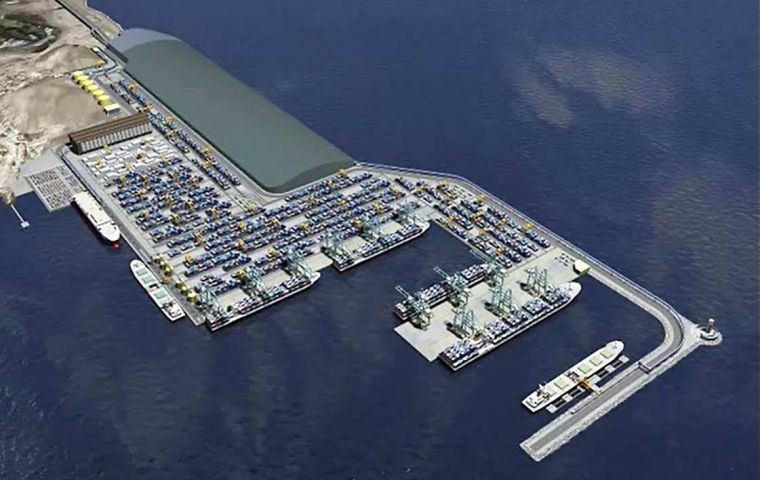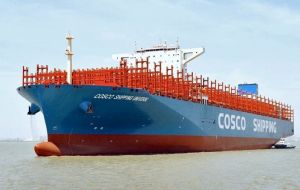MercoPress. South Atlantic News Agency
China building a new port and industrial hub in Peru, US$ 3bn investment, 55kms north of Lima
 At Chancay, 55 kilometers north of the capital Lima and the port of Callao thousands of workers move around the 1,100-hectare site.
At Chancay, 55 kilometers north of the capital Lima and the port of Callao thousands of workers move around the 1,100-hectare site.  Under Cosco’s plan, the port will be able to handle the world’s largest container ships and process up to 1 million standard containers a year
Under Cosco’s plan, the port will be able to handle the world’s largest container ships and process up to 1 million standard containers a year Global chain transport challenges, the war in Ukraine, and following two years of lockouts caused by the Covid 19 pandemic have caused many disruptions to normal trade and China has thus embarked in a major project building a new port along the Peruvian coast to help boost trade along the Pacific rim.
In effect, Chinese state-owned conglomerate Cosco Shipping Holdings is building – virtually from scratch – a deep-water port in Peru. At the cost of US$ 3 billion, it will connect an industry and a logistics park in collaboration with a unit of the Swiss trading company Glencore.
At Chancay, 55 kilometers north of the capital Lima and the port of Callao the hum of heavy Chinese machinery and the thud of underground explosions drowning out the sound of waves are proof of the new port development underway in the Americas.
Signs in Spanish and Chinese announce construction milestones and upcoming public works. Thousands of workers move around the 1,100-hectare site, pouring concrete, driving construction equipment, and breaking rocks.
China Railway Group is building a 1.8 km tunnel from the port area so that trucks heading to the 800-hectare industrial and logistics park can bypass Chancay city center. Cosco operates in around 35 ports worldwide, but Chancay will be the conglomerate’s first outpost in South America.
“Cosco Shipping will cooperate with Peru to make the Port of Chancay into an important central port in Latin America,” President Xu Lirong said in 2019 when the company closed the deal to buy 60% of the Volcan unit project from Glencore for US$ 225 million.
“The Port of Chancay is an important initiative to implement China’s Silk Road initiative in Peru,” he added.
Cosco has been joined by state owned partner companies China Railway Group and China Communications Construction, and especially its China Harbor Engineering unit, which is leading the construction of the new port.
Under Cosco’s plan, the new port will be able to handle the world’s largest container ships and process up to 1 million standard containers a year, with the first quays opening within a year.
“The port is planned to grow, and we have room to continue expanding for 50 years,” said Gonzalo Rios, the port’s deputy general manager. “There’s no other project like it, in size and construction technology today,” he said.
Peru’s main value to China as a trading partner is copper, a crucial input used in manufacturing and construction. However, while Chinese state-owned companies manage two of Peru’s biggest copper mines, their production is not expected to be shipped via Chancay. That’s because Cosco is prioritizing shipping infrastructure and agricultural commodities. Fishmeal is another major Chinese import from Peru.
Peru’s container trade with China lags well behind neighboring Chile. Chile received 643,958 twenty-foot equivalent units (TEU) of containers last year from China, while it shipped 331,047, according to S&P Global Market Intelligence’s Panjiva data service. For Peru, the numbers were, 397,046 TEU entered, and 133,239 exited.
The port of Callao, on the outskirts of Lima, today the main commercial port in Peru and the busiest container center in South America's western coast handled around 2.4 million TEU. The port unit of the Danish shipping company A.P. Moller-Maersk controls the north side of Callao. At the same time, Dubai terminal operator DP World manages the south, where it is investing US$ 350 million to expand capacity.
Cosco is now behind Maersk on the trans-Pacific service to the west coast of South America. According to data released last year by research service BlueWater Reporting, the Danish group controlled 21% of capacity along the trade route. Cosco was tied in second with two other shipping lines at 14%.
However, the share of Cosco can be expected to grow once the company’s new port in Peru is up and running.
“This is a strategic development,” said Peter Sand, chief analyst at shipping data service Xeneta in Oslo (Norway). “If it goes according to the plans outlined, it will become a hub for Chinese container exports on the South American continent.”
“Some Chinese state investments have a different objective than classic commercial and financial success,” he added. “The objective is broader, strategic, and long-term.”
According to Omar Narrea, a management professor, Chancay would be a growth driver for Peru if the country is able to stimulate development in planned surrounding industrial parks that might take advantage of the new port and its location along the Pan American Highway.




Top Comments
Disclaimer & comment rulesCommenting for this story is now closed.
If you have a Facebook account, become a fan and comment on our Facebook Page!